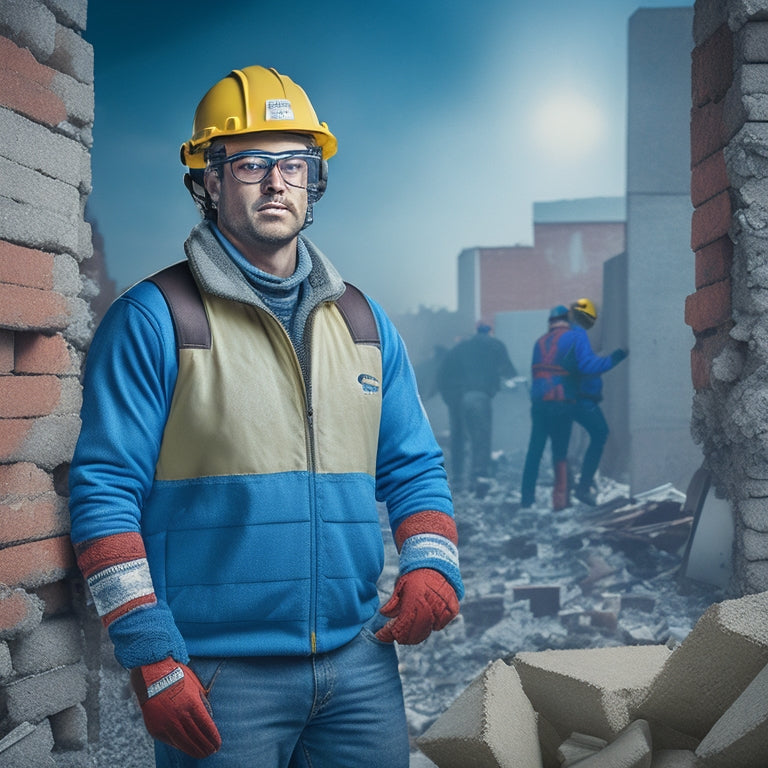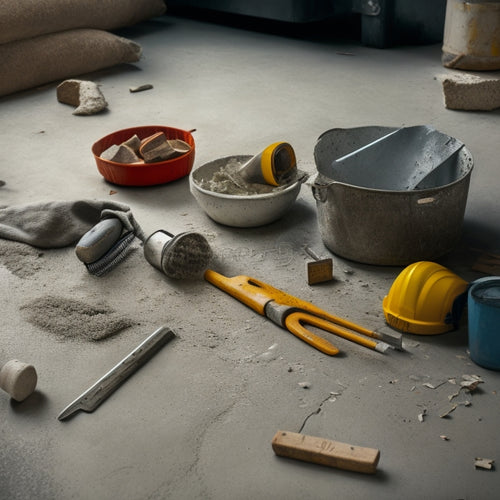
5 Tools for Removing Concrete Blocks Easily
Share
You'll need the right tools to remove concrete blocks efficiently and safely, and that's where these five specialized tools come in - each designed to exploit the weaknesses of concrete blocks and make the removal process easier. A wrecking bar provides mechanical advantage for gentle prying, while a jackhammer brings powerful force for heavy lifting. For precise control, a pry bar or drill and chisel combo can be effective, and a hydraulic splitter applies immense force along natural fault lines. By understanding the strengths and weaknesses of each tool, you'll be able to tackle even the toughest concrete block removal projects with confidence, and discover the best approach for your specific job.
Key Takeaways
• Utilize a wrecking bar for leverage, identifying the fulcrum point and using body weight to amplify force for efficient block removal.
• Employ a jackhammer for heavy lifting, following safety guidelines and maintenance tips for optimal performance and accident prevention.
• Use a pry bar for precise control, positioning it at a 45-degree angle and applying steady pressure for delicate block dislodging.
• Combine a drill and chisel for breaking down stubborn blocks, using hammer drill techniques and selecting the right chisel for the job.
• Leverage a hydraulic splitter for immense force, maintaining consistent pressure and regular maintenance for effective block separation.
Wrecking Bar for Leverage
When dismantling a concrete block structure, use a wrecking bar to pry blocks apart, leveraging the tool's curved end to gain maximum mechanical advantage. You'll find that the curved end provides an excellent fulcrum point, allowing you to apply force efficiently and safely.
To pry blocks apart, insert the curved end into the joint between two blocks and apply gentle, consistent pressure. As you do so, use your body weight to amplify the force, keeping your back straight and your feet shoulder-width apart.
Mastering wrecking bar techniques requires understanding leverage applications. The key is to identify the best fulcrum point, which varies depending on the block's size and the joint's width.
Experiment with different angles and positions to find the sweet spot, and always maintain control over the tool. Remember to work methodically, prying one block at a time to avoid destabilizing the structure.
With practice, you'll develop the skills to dismantle concrete block structures efficiently and safely using a wrecking bar.
Jackhammer for Heavy Lifting
You'll likely need a jackhammer to break up and remove large, heavily reinforced concrete blocks or those deeply embedded in the structure. This powerful tool is essential for heavy lifting and demolition tasks.
When operating a jackhammer, prioritize safety above all else. Always wear protective gear, including gloves, safety glasses, and a dust mask, to prevent injury from flying debris and vibrations.
Guarantee the jackhammer is properly maintained by regularly checking and replacing worn or damaged parts, such as the chisel bit and air filter. Proper jackhammer maintenance won't only extend the tool's lifespan but also optimize its performance and reduce the risk of accidents.
Additionally, follow the manufacturer's guidelines for lubrication, storage, and handling to prevent damage and guarantee jackhammer safety.
Pry Bar for Precise Control
For smaller, more delicate concrete blocks or those in tight spaces, a pry bar offers the precise control needed to carefully dislodge and remove them without causing damage to surrounding structures.
When using a pry bar, you'll want to employ specific techniques to maximize its effectiveness. Start by positioning the pry bar at a 45-degree angle, with the curved end wedged into the gap between the block and the surrounding material. Apply steady, controlled pressure, using your body weight to generate force rather than relying on brute strength. This will help you maintain precision and avoid applying too much pressure, which can cause damage or breakage.
As you work, prioritize pry bar safety by wearing protective gear, including gloves, safety glasses, and a dust mask. Confirm the area is clear of obstacles and tripping hazards, and maintain a secure footing to avoid slipping or losing balance.
Drill and Chisel Combo
By combining a drill with a chisel, you can effectively break down and remove concrete blocks, especially those that are large or stubborn. The drill's rotary action helps to weaken the block's structure, making it easier for the chisel to dislodge and remove.
This combo is particularly useful when dealing with concrete blocks that have been reinforced with rebar or have a high compressive strength. To maximize efficiency, employ drill techniques such as using a hammer drill with a masonry bit to create holes or channels in the block. This will allow the chisel to penetrate deeper and break off larger chunks.
When selecting a chisel type, opt for a flat or claw chisel, as these are better suited for prying and breaking concrete. As you drill and chisel, work in small sections, focusing on one area at a time to maintain control and avoid damaging surrounding structures.
Hydraulic Splitter for Force
Employing a hydraulic splitter for force allows you to harness immense power to crack and separate concrete blocks along their natural fault lines, providing a highly effective means of demolition. This tool is particularly useful when dealing with large or thick blocks that require significant force to break apart. One of the primary splitter advantages is its ability to apply consistent pressure, which helps to reduce the risk of block fragmentation and prevents damage to surrounding structures.
To guarantee peak performance, it's crucial to perform regular hydraulic maintenance on your splitter. This includes checking the hydraulic fluid levels, inspecting the piston and cylinder for signs of wear, and replacing any damaged or worn-out components.
By doing so, you'll be able to maintain the splitter's force output and extend its lifespan. Additionally, proper maintenance will also reduce the risk of equipment failure, which can lead to costly repairs and downtime.
Frequently Asked Questions
What Safety Gear Is Required When Removing Concrete Blocks?
When tackling concrete block removal, you'll need to prioritize safety.
You're required to wear protective clothing, including long sleeves, pants, and gloves to prevent skin abrasions and cuts.
Don't forget safety goggles to shield your eyes from flying debris and dust.
Additionally, consider a dust mask or respirator to prevent inhaling harmful particles.
Ascertain you have a sturdy hard hat to protect your head from falling blocks or tools.
Can I Use These Tools for Removing Other Types of Masonry?
As you venture into the domain of masonry removal, you'll find that the right tools can be a game-changer.
Now, you're wondering: can I use these tools for removing other types of masonry? The answer is yes, but with caution.
You'll need to adapt your masonry removal techniques and potentially switch to alternative masonry tools, depending on the specific material you're working with.
For instance, you might require a diamond blade saw for cutting through thick stone or a chisel set for more delicate brickwork.
How Do I Dispose of the Removed Concrete Blocks?
When you're done removing concrete blocks, you'll need to dispose of them responsibly.
First, check your local disposal regulations to guarantee you're meeting the requirements.
Consider concrete recycling options, which can reduce waste and conserve natural resources.
You may need to transport the blocks to a designated recycling facility or landfill that accepts construction materials.
Make sure to follow proper loading and transporting procedures to avoid damage or safety hazards.
Are There Any Environmental Concerns When Using These Tools?
When tackling demolition projects, you're likely aware of the importance of minimizing environmental impact.
You'll want to guarantee that your methods align with sustainable practices to reduce waste and pollution.
In particular, you should consider the dust and debris generated during concrete block removal, as well as the potential for chemical contamination.
Can I Rent These Tools Instead of Buying Them?
You're literally flooded with tool options, but buying them all might break the bank!
Luckily, you can rent the tools you need, and it's worth doing a cost comparison to see which route saves you more.
For instance, a demolition robot might be pricey to own, but renting it for a day could be a game-changer.
Research local tool rental shops and calculate the costs to determine the most economical approach for your project.
Conclusion
You've finally cracked the code to removing concrete blocks with ease.
Like a master puzzle solver, you've got the right tools in your arsenal to dismantle the toughest concrete structures.
With these five tools, you're equipped to tackle any concrete removal project that comes your way.
Just remember, each tool is a specialized instrument in your orchestra, working together in harmony to produce a symphony of destruction.
Related Posts
-

10 Best Tools for Sealed Concrete Flooring on Budget
When starting on a sealed concrete flooring project on a budget, you'll need to prioritize essential tools without sa...
-

Top 10 Concrete Repair Tools for Small Fixes
You'll need the right tools to tackle small concrete repairs efficiently and effectively. When it comes to small fixe...
-

10 Must-Have Tools for Small Concrete Projects
When tackling small concrete projects, you'll need a range of essential tools to achieve professional-grade results. ...


